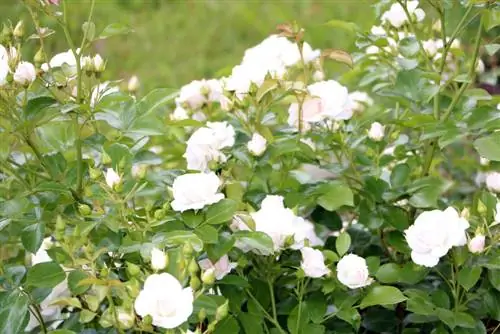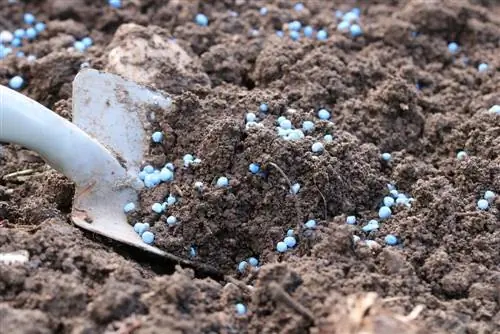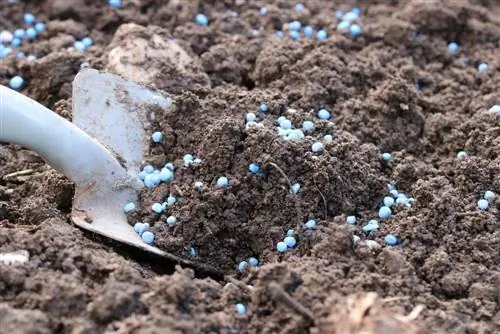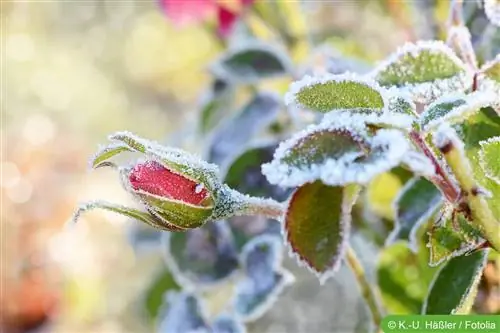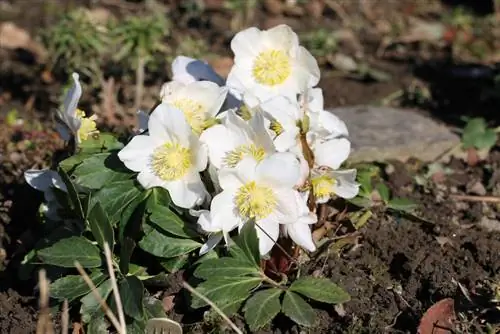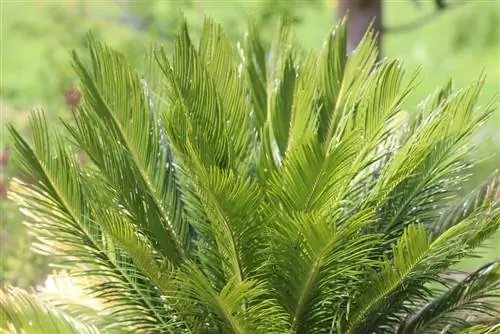- Author admin [email protected].
- Public 2023-12-17 03:39.
- Last modified 2025-06-01 06:48.
Caring for roses in summer brings the rose to perfect bloom, which is why summer pruning is very important. And the flower only grows to a large size with the right nutrition through fertilizer:
Why summer cut (why cut at all)?
Roses are designed to be pruned (several times) during the growing season.
If you were to simply let the rose grow, it would grow like a wild rose, i.e. with a completely different growth habit: long, weak shoots growing in a messy mess, with a few flowers hanging at the extreme ends. However, since it is a cultivar that lost some of its resistance when breeding for special flowers, it would probably not be able to cope with the freedom to grow at all, but would be eaten up by fungi and/or pests.
Only the right cut keeps the cultivated rose in the right shape. This correct pruning involves several pruning measures per year: spring pruning at the beginning of budding, summer pruning after flowering and possibly autumn pruning at the beginning of the winter dormant phase. These pruning measures each have their own purpose: Spring pruning is the most important main pruning in order to provide targeted growth incentives and specify the desired growth form; Autumn pruning serves to prevent illness. Summer pruning is the most important pruning after spring pruning and can make autumn pruning unnecessary if it is carried out late in the year and very comprehensively.
The summer cut
With summer pruning, the faded flowers of the season are removed in order to keep the rose airy to ward off fungi and encourage it to bloom again. A slightly different cut is recommended for the various groups of roses. Here is an overview of all rose varieties or their four main groups:
Summer pruning of floribunda roses
The classic “bed roses” include the large-flowered noble roses and the multi-flowered polyanthar roses, but also the dwarf roses and ground cover roses that bloom one floor lower.
These varieties are grown on compact growth and are said to produce many flowers on short shoots. In order for flowers to come back, spent flowers on a rose shoot must be cut away:
- Cut the flower shoot back to where the next well-developed five-leaf grows
- Cut back long-shooting varieties so that the next flower floret blooms at approximately the same level
- The withered shoot often has to be shortened by more than 20 cm
- After cutting, the rose definitely needs some fertilizer
- A further bloom can be expected about 6 weeks after cutting
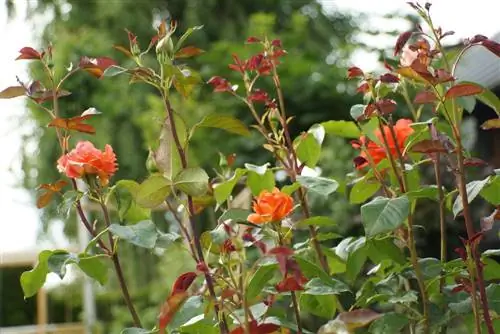
Once you have successfully carried out this pruning for a few years, you can switch to “advanced floribunda rose summer pruning”, which aims at continuous flowering throughout the summer:
- Thin out bud-bearing rose shoots three weeks before the first flowering
- Remove flower buds and 3 to 4 leaves under the buds on every third or fourth shoot
- While the remaining shoots are still causing the first flowering, the pruned shoots begin to grow again
- They bloom a few weeks after the first flower
- In the meantime, the shoots of the first flower have been shortened, which are now producing new buds
- When thinning, it is best to shorten particularly vigorous shoots
Summer pruning of shrub roses
Among the more luxuriantly flowering and “messily” growing shrub roses, there are once-blooming varieties, modern more frequently blooming varieties and historical roses, which are treated slightly differently in terms of pruning:
Single-blooming shrub roses
Once-blooming shrub roses often need to be slowed down a bit during the first flowering period. Because here it is not uncommon for young shoots to take off violently and in their zeal cover up deeper buds/flowers. These fast-growing shoots can and should be slowed down; it is best to cut them back during the first flowering to or just below the level of the flowers that are currently blooming so that they can really come into their own.
The once-blooming shrub roses only get the “actual summer cut” when the first flower has completely faded. The spent flowers are removed with a piece of shoot with two to three leaves; you can then cut the shrub rose into shape. But not too much, it's more about reintegrating new shoots that have grown too long into the general height of the bush and giving the bush an overall attractive shape.
Frequently blooming shrub roses
Frequently blooming shrub roses are removed from the spent flowers after the first bloom; Here too, a few shoots that are too strong and too vigorous may need to be shortened to suit the shape of the bush.
Shrub roses that bloom more often do not need more pruning in summer. In particular, the St. John's shoot that appears from June 24th should initially remain on the bush, even if these long basic shoots grow beyond the normal height of the bush in August/September. These basic shoots are important for rejuvenating the shrub and should mature over the winter; Only during spring pruning are the St. John's shoots from the last season adjusted to the general height of the bush.
Tip:
You don't necessarily have to take away the spent flowers: rose hips are formed from simple flowers, which not only look beautiful, but can also be made into tea or jam. However, if the rose has double flowers, they can usually be cut away because no fruit is expected anyway.
Historic rose bushes
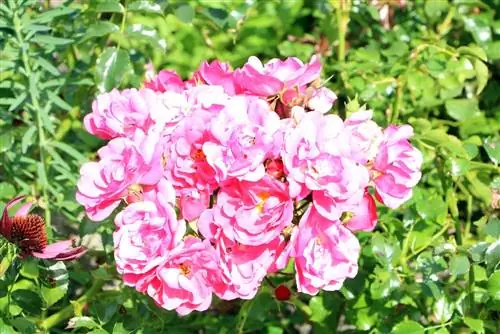
Historic rose bushes are often old not only in terms of the cultivar, but also in actuality. They are usually single-blooming roses that can remain uncut for several years because they do not grow very vigorously. You should also avoid cutting out old shoots and dead wood during the season because the lush shrub needs these “supports” to prevent it from collapsing.
If shrub roses show more and more bare shoots on the inside, there is a risk of aging; Long, uncut bushes also lie on the side facing the sun over time and become hemispherical bushes. The necessary rejuvenation is best carried out in summer because the rose is full of sap and cuts are quickly closed again: cut back the old, out-of-shape bush immediately after flowering, by at least half or even more. By autumn, the shrub has already developed many new shoots, from which lush flowering can be expected next season.
Summer pruning for climbing roses
For climbing roses, the annual spring pruning only begins when the first strong shoots have exceeded a height of around two meters (in the 2nd or 3rd year). Before that, you can exert some influence with form education:
- Tie as many shoots as possible horizontally to the climbing aid
- Slows down the growth of the shoots and ensures lots of lateral flower shoots
- An area is quickly covered by a sea of flowers when the shoots are arranged in a fan shape
- Lead shoots in a spiral upwards on columns
- In the first 2 or 3 years, use summer pruning to complete a task of later spring pruning:
- Cut away young shoots that are growing diagonally, sparingly and strangely, which only cost the rose energy
- Short and with an inward eye, they rebuild themselves until autumn
Otherwise, the faded roses of the climbing roses are cut out in summer, but this continues throughout the entire flowering period. Young shoots that grow early and wild in the area should be pinned under; they produce the best flower shoots later. “Ordinarily growing” St. John's shoots, which start growing properly after June 24th, are definitely retained; these basic shoots keep the climbing rose young (and help it to gain a lot of height if desired). However, the long rods have to be tied/braided like premature St. John's shoots. When the first basic shoots are around 5 years old, one shoot after the other is gradually cut down to the base in the summer and replaced by appropriately growing young shoots.
Rejuvenation of old climbing roses with few shoots that show few flowers at unreachable heights is also best done in summer because the severe wounds heal best now and are safely closed before the rose has to deal with winter cold. After flowering, cut back half of the old shoots to around 30 cm above the ground. If these shoots regenerate by the next season, next summer it will be the turn of the remaining shoots and you will have an almost new rose. If an old rose is very slow to regenerate, you can try to rejuvenate a little more slowly, for example next time. B. only cut away a third. In an emergency, you can try to take cuttings in time to “replace” the outdated rose with yourself.
Summer pruning of rambler roses
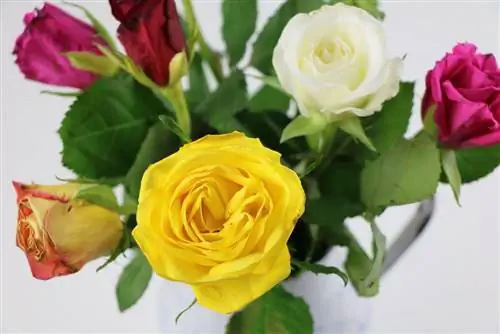
Rambler roses also climb, but they differ from “normal climbing roses” in that they do not grow to a height of 5 m, but develop one small flower next to the other at heights of up to 30 m. Bud formation begins on the previous year's shoots, not on fresh shoots as is the case with climbing roses. That's why the classic rambler rose is only pruned in summer, if at all, because if you prune in spring you would cut away the flower heads. Classic rambler roses don't necessarily need to be pruned much, neither in summer nor otherwise:
Classic, strong-growing rambler roses that grow over trees or walls are only relieved of annoying shoots if they cannot be integrated. If a cut e.g. If, for example, it is necessary because of the height, it should be carried out in the summer after flowering so that the rose can recover over the autumn-winter period and has time to form new flower shoots for the coming season.
In the case of rambler roses on columns or trellises, the withered flower shoots can be removed immediately after flowering, as well as unsightly young shoots growing out and other annoying, weak, diseased plant shoots. Here too, too many young shoots can and must be used at some point to replace outdated shoots.
The name “Ramblerrose” (German Schlingrose) is a collective term; It includes strongly climbing (or creeping) wild rose hybrids, in the cultivation of which a wide variety of wild rose species are used. That's why the rambler roses differ greatly in their growth behavior - although they all have a somewhat wild growth habit (to ramble=wander around), varieties that bloom more often, such as 'New Dawn', remain significantly smaller than their fast-growing relatives and produce flowers almost always and everywhere, regardless of whether it is a previous year's or a fresh shoot. The smallest of these modern ramblers do not reach a height of more than 2 meters. Depending on the bud setting, they resemble climbing roses much more than classic rambler roses and should then be pruned like climbing roses.
Time and editing
- This is what matters when it comes to summer cutting -
The best time for summer pruning is when the first flowers are wilting. The rose should be quickly freed from the remains of the flowers because it should not put energy into fruit formation, but into the next set of flowers. With modern cultivated miracles with double flowers, you can remove the withered flowers while they are blooming; This doesn't bother these roses because the flowering is over anyway (these roses are usually unable to produce fruit). Malformed, diseased, weak shoots can be removed at any time; radical cuts should not be made too late in the summer and, if possible, in pleasant, dry weather.
Cut a piece below the old flower, just above the next five-leaf shoot or two to three pairs of leaves below. Strong shoots should always be cut back only slightly; You can cut back weak shoots more, then the cut will immediately stimulate growth.
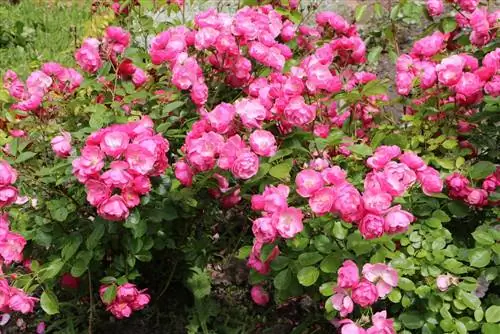
With summer pruning, the wild shoots that sprout below the grafting point on the root neck of grafted roses must be removed. Their leaves usually have a different color, are smaller than the leaves of the graft, but consist of seven, eight, nine pairs of leaves. The refined cultivar is placed on this wild rootstock because it is too weak on its own to grow and form roots in normal soil. The base does “all the root work in the ground” anyway and of course likes to try to see some sun above the ground. If it takes over, your garden will soon no longer be adorned with the noble “Madame Dingsda” with bright giant flowers, but with one simple wild rose flowers. So the wild shoots have to be pulled out or removed, preferably as deep as possible, because this provokes the least amount of offspring (carefully remove the soil around the roots a little).
Tip:
If you have a grafted rose in the garden, you should know where the graft is located so that you can really identify the wild shoots with certainty. Because the distinction between five or more leaves is only a clue; The grafters also sometimes come up with the idea of shooting seven or nine-leaved shoots - and are often ruthlessly robbed of this because the pruning gardener simply "removes all the shoots at the bottom" out of ignorance.
Rose care in summer
- Fertilizer is urgently needed -
Roses are planted in spring in a well-prepared bed that provides all the necessary nutrients. Nevertheless, the rose needs replenishment when it is about to bloom because the formation of flowers takes up energy and nutrients. Mineral fertilizer can be given in June, organic fertilizer in the form of horn shavings or compost right after the first blossoms appear because it has to be decomposed again. If organically fertilized roses show a clear need for nutrients at the beginning of flowering, you should give organic liquid fertilizer, bought ready-made or made yourself from compost. But don't be too aggressive here either (roses also react sensitively to too much "natural nitrogen"), but rather add some fertilizer later.
With mineral fertilization, some fertilizer usually has to be added at the end of July because the nutrient injection from June has already been exhausted. From the end of July, the roses should no longer be fertilized so that new shoots are no longer formed and the shoots that have already formed have time to mature until winter.

